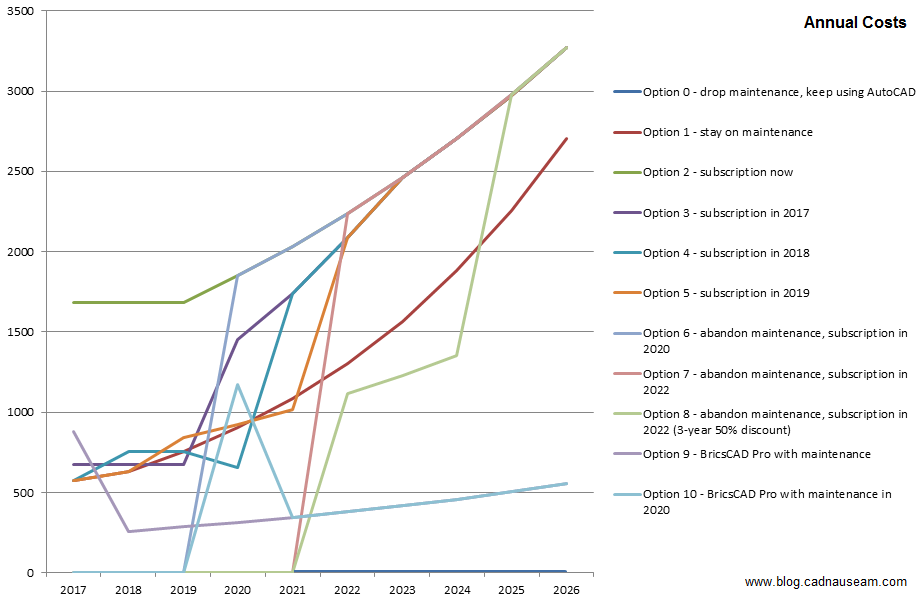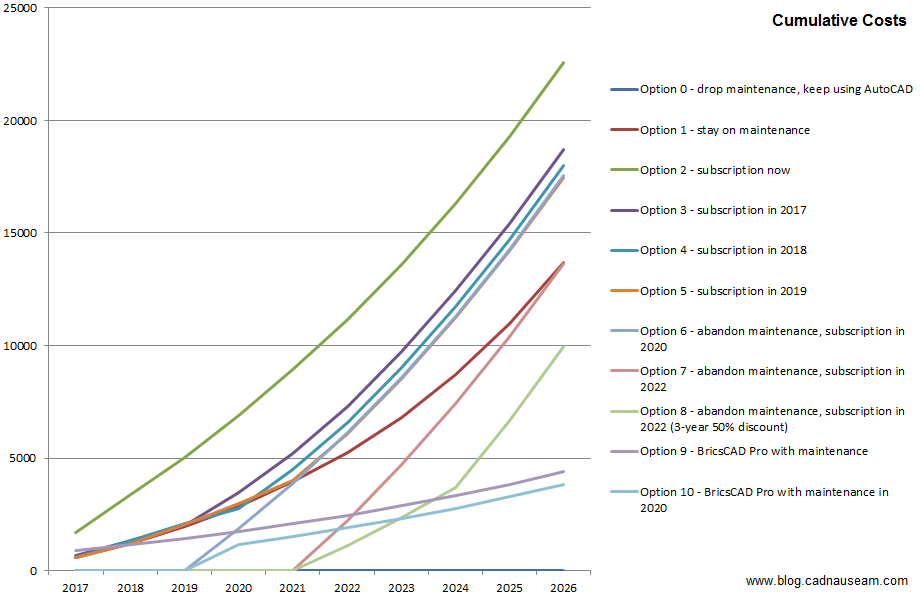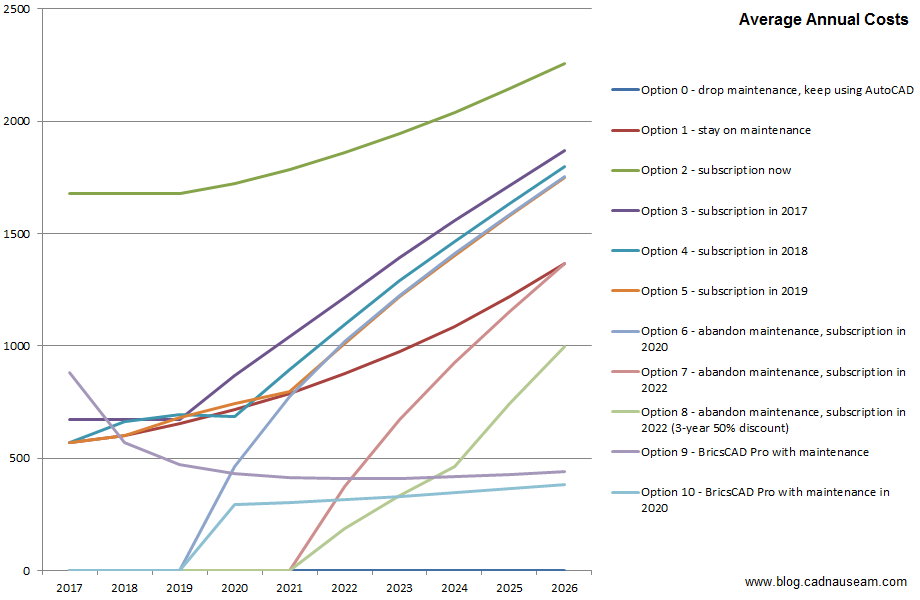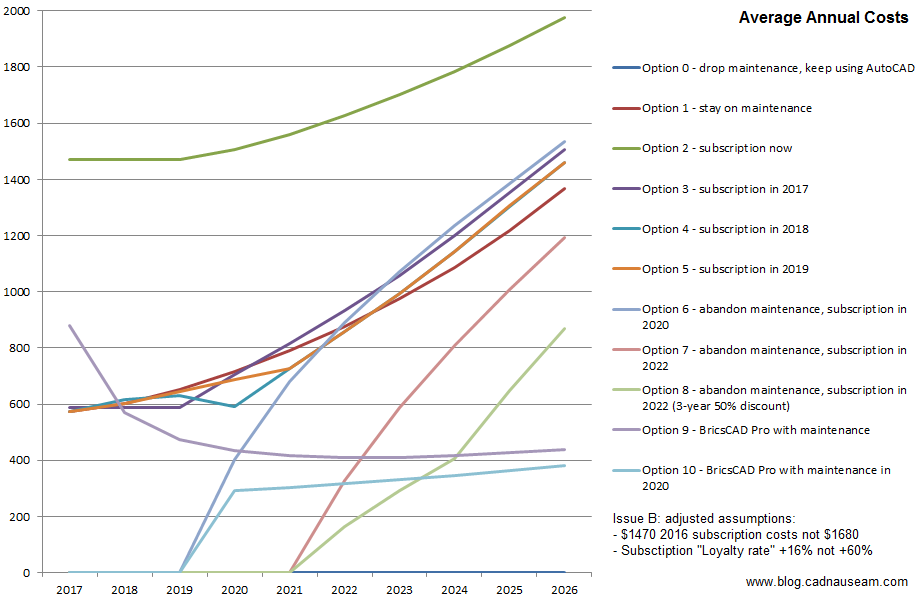Note: an updated version of this post is available, using new costing information from Autodesk that was unavailable when this original summary was written.
In this series of posts, I have examined various payment options for CAD software and compared them with the cost of staying on your Autodesk maintenance contract long-term.
In this fourth and final post, I will examine the validity of the various assumptions I have made; lay out all the data with best/worst options lists; provide combined graphs; and sum up.
However, that means this is a very long post. I want to ensure one essential point doesn’t get lost, so I’ll state it right up front. I will fully justify it later with objective evidence, but for now, here it is:
DO NOT switch from maintenance to subscription.
Just don’t do it. It makes no sense to do it on any level. You would throw away your valuable perpetual license, of course, but that’s not all. Despite what Autodesk is implying in its sleight-of-hand marketing, subscription will cost you more money.
Assumptions
Because Autodesk isn’t telling customers all they need to know in order to make a rational choice, I’ve had to make some assumptions in order to work out the relative viabilities of the various options. Here, I’ll lay those assumptions out and explain why I made them. Some of them are very soundly based, others less so.
- Autodesk will continue to make maintenance available long-term. This has been repeated by Autodesk people at all levels and is currently pledged in writing on Autodesk’s web site. On the other hand, Autodesk has said one thing and done the other on multiple occasions, so who knows? Autodesk is also making noises about how terrible it is for the poor thing to have to go on operating in the same way that has made it billions for decades. I certainly can’t promise that Autodesk’s promise is worth the pixels it’s written on. It’s safe to assume that Autodesk will do all sorts of nasty things to maintenance customers over the next few years, but I’m relying on our fortitude in standing up to that.
- The maintenance price increases of 5%, 10% and 20% are cumulative, resulting in actual price increases of 5%, 15.5% and 38.6%. This has been confirmed by Autodesk here.
- Following that set of increases, the cost of maintenance will increase by another cumulative 20% per year. This is a total guess. I can’t imagine Autodesk reverting to 0% a year, but it’s always possible the increases could be worse than this. The increases could be more stepped than this assumed smooth progression (e.g. 50% one year, 0% the next). Anything could happen, and Autodesk isn’t telling us. I’ve chosen what appears to be a likely middle ground.
- Subscription (rental) prices will be frozen until after 2019. I’ve assumed this because Autodesk will want to keep subscription looking good in comparison to maintenance while it tries to persuade people to come on board.
- Subscription prices will increase 10% per year from 2020. Another guess. I’m pretty sure the price will keep going up, and it may be worse than this if Autodesk gets a sizeable portion of existing users tied in by then. Autodesk will rack up prices as high as it thinks it will get away with. My 10% assumption, if it’s low, will make subscription look better than it really is in my comparisons.
- The offered 60%/55%/50% discount on subscription will be maintained for three years from the point of changeover, not three years from now. That appears to be implied in Autodesk’s statements, and a three-year lock-in appears to be a standard Autodesk marketing technique.
- Following the three-year lock-in, the subscription cost will then change to 60% more than maintenance. This is being kept secret from customers but has been stated to stock market analysts by Amar Hanspal.*
- This 60% premium will be based on the maintenance price at the time, not the original pre-increase price. I can’t imagine Autodesk choosing the lower-cost version of a 60% premium, can you?
- The maintenance plus 60% price will be capped to always remain below the subscription price at the time. This is based on Autodesk’s promise that customers who convert to subscription in 2017/8/9 will always receive some non-quantified discount.
- The amount the maintenance plus 60% price remains below the subscription price will be minimal. I’ve assumed $1 below the subscription price. Maybe that’s harsh, but because Autodesk is refusing to quantify this discount amount, I think it’s fair to assume we won’t like the size of it.
- For option 8, Autodesk will offer maintenance customers who switch over in 2022 a 50% discount on subscription, locked in for 3 years. Autodesk has made very similar offers over the last year or so. I’m assuming such offers will continue to arise from time to time, but there are no guarantees.
- Bricsys will continue to provide perpetual license and maintenance options. I’m highly confident in this one. Autodesk’s rental-only move is manna from heaven to Bricsys, and the availability of perpetual licenses is a big drawcard for disaffected Autodesk customers. Bricsys won’t throw away that competitive advantage.
- For options 9 and 10, BricsCAD purchase and maintenance costs will rise by 10% a year (compound). Another guess. Based on the Bricsys price history to date, 10% may be on the high side. However, because Bricsys prices are so much lower than Autodesk ones, an error in this assumption will have a much smaller effect than errors in the Autodesk price assumptions.
Like all assumptions, those above could be wrong. On multiple occasions I have offered Autodesk the chance to correct these assumptions and replace necessary speculation with information. Indeed, when I re-started my blog in April last year I made a point of emailing Autodesk PR to inform them that I would be covering the subject of rental in a critical way and inviting their participation. No response.
As with all content on my blog, I actively encourage being corrected on any factual inaccuracies. I will happily correct errors that are pointed out to me by anybody, and have done so on several occasions. If at some point in the future, Autodesk decides to become transparent with the long-term cost implications of switching to maintenance and decides to open up to me in particular or customers in general, I’ll dedicate a new post to that information and link to it from this post.
Data
If you want to examine the full set of data and/or make adjustments to the values, assumptions or calculations, here is the Excel spreadsheet I used.
The following tables show the cost winners and losers after the first three, five and ten years based on one AutoCAD license with a 2016 maintenance cost of $545 and 2016 subscription cost of $1680.** All values are in US dollars.
Three years
| Average Annual Cost | Option |
| 0 | Option 0 – drop maintenance, keep using AutoCAD |
| 0 | Option 6 – abandon maintenance, subscription in 2020 |
| 0 | Option 7 – abandon maintenance, subscription in 2022 |
| 0 | Option 8 – abandon maintenance, subscription in 2022 (3-year 50% discount) |
| 0 | Option 10 – BricsCAD Pro with maintenance in 2020 |
| 474 | Option 9 – BricsCAD Pro with maintenance |
| 652 | Option 1 – stay on maintenance |
| 672 | Option 3 – subscription in 2017 |
| 681 | Option 5 – subscription in 2019 |
| 695 | Option 4 – subscription in 2018 |
| 1680 | Option 2 – subscription now |
Five years
| Average Annual Cost | Option |
| 0 | Option 0 – drop maintenance, keep using AutoCAD |
| 0 | Option 7 – abandon maintenance, subscription in 2022 |
| 0 | Option 8 – abandon maintenance, subscription in 2022 (3-year 50% discount) |
| 303 | Option 10 – BricsCAD Pro with maintenance in 2020 |
| 416 | Option 9 – BricsCAD Pro with maintenance |
| 776 | Option 6 – abandon maintenance, subscription in 2020 |
| 790 | Option 1 – stay on maintenance |
| 796 | Option 5 – subscription in 2019 |
| 895 | Option 4 – subscription in 2018 |
| 1041 | Option 3 – subscription in 2017 |
| 1784 | Option 2 – subscription now |
Ten years
| Average Annual Cost | Option |
| 0 | Option 0 – drop maintenance, keep using AutoCAD |
| 383 | Option 10 – BricsCAD Pro with maintenance in 2020 |
| 439 | Option 9 – BricsCAD Pro with maintenance |
| 995 | Option 8 – abandon maintenance, subscription in 2022 (3-year 50% discount) |
| 1365 | Option 7 – abandon maintenance, subscription in 2022 |
| 1366 | Option 1 – stay on maintenance |
| 1748 | Option 5 – subscription in 2019 |
| 1753 | Option 6 – abandon maintenance, subscription in 2020 |
| 1798 | Option 4 – subscription in 2018 |
| 1871 | Option 3 – subscription in 2017 |
| 2257 | Option 2 – subscription now |
Graphs
These graphs show all ten options together.
Annual Costs
Cumulative costs:
Average annual costs over time
I’m not sure how useful the combined graphs are; with ten options things can get a bit muddled. Feel free to mess with the spreadsheet to produce the graphs that interest you. If you hide rows, those options won’t show up in the graphs.
Summary
You may feel it’s pointless trying to work out the best thing to do up to ten years into the future. I disagree. We are forced to do so. Many customers have been paying Autodesk for decades, and without this disruption would probably have continued to do so for decades to come. Now Autodesk is asking us to make a decision that will have effects that go way beyond ten years into the future.
Ten years isn’t really that long in AutoCAD terms, particularly given the recent glacial level of progress. Remember the _XREF_XREF_XREF debacle as if it were yesterday? Still occasionally opening drawings with that problem? That bug was unleashed on the public ten years ago this month.
Autodesk is asking us to make a permanent, irreversible, long-term decision based on very limited short-term information. After that? We are expected to trust in Autodesk and hope for the best. Sorry, but if you’re prepared to meekly go along with that, you haven’t been paying attention. You might as well just give Autodesk your Internet banking login information and say, “Help yourself to whatever you like.”
If you run the numbers based on the assumptions above, it’s easy to see the best and worst things you can do from a cost point of view, particularly beyond the short term. The high-cost options all involve switching to subscription. The further ahead you look, the worse a deal subscription becomes.
Forget Autodesk’s talk of vanishing discounts, saving money by moving earlier, etc. The opposite is true. Doing what Autodesk wants will result in you paying much more; maybe three or four times the amount you need to. Because that’s the whole point of Autodesk’s rental scheme.
Here’s the bottom line.
Switching from maintenance to subscription will cost you more money.
As a bonus, you get to throw away a perfectly good permanent license. Burn your boats and enjoy a costly cruise to Empty Wallet Land on board SS Subscription? You’d have to be completely crazy.
Posts in this series:
1. Autodesk license costs options 1 & 2 – stay on maintenance, subscription now
2. Autodesk license costs options 3, 4 & 5 – bait and switch
3. Autodesk license costs options 6 to 10 – abandon maintenance or Autodesk
4. Autodesk license costs options – summary
5. Autodesk license costs options – summary 2
Edit:
* It appears Amar may have been misquoted in the transcript I read and the number is actually 16% rather than 60%. An updated transcript with the former number can be found here.
** I am informed that the price was reduced from $1680 to $1470 in August.
It’s worth noting that even with the above adjustments entered into the spreadsheet, the conclusions made above still appear to hold true. Here’s the resultant average cost graph:
I’ll run another post later with more detail when I’ve collated as much information as I can. I have yet again invited Autodesk to provide information with which to replace the assumptions.






makes you wonder if all this is just a way to make major increases in maint costs look good. The ones that don’t care won’t notice. This is so odd to me though because the ones that don’t notice are new customers with no history. There can’t be very many of those these days. Acad and other adesk offerings have been around too long.
If so, Autodesk has a funny idea about what looks good.
Also, if staying on main is really the best route, Adesk would argue this is because they want to reward us for our past loyalty. I don’t expect them to be loyal to us though as honestly I have no serious loyalty to them. They have one of the best product for what we do, and choose to take the risk of tying up my data in their formats. Its not out of love, I assure you.
> You might as well just give Autodesk your Internet banking login
> information and say, “Help yourself to whatever you like.”
That seems to work for Bentley. A pox on both their houses.
The Annual Cost of AutoCAD is $1470.00 per year. Autodesk price cut last August.
Thank you, I’ll look into that. You can easily enter that number into the spreadsheet and see how that changes things.
If accurate, this an easily corrected assumption that was left uncorrected by Autodesk despite multiple requests for such correction. There are probably others. For example, there’s a strong argument that Amar said or meant 16% rather than the quoted 60% that is the basis for assumption 7. Again, that can easily be entered into the spreadsheet. Again, that could easily have been corrected by Autodesk and wasn’t.
Corrections and clarifications are welcome from any source, especially Autodesk.
I’ll run another post later when I’ve collated as much information as I can.
Hello
Just wondering your take on the letter I just received:
We want to take a moment to share the direction Autodesk is heading—some upcoming changes that will affect your maintenance plan—and a special offer to move to subscription that you may want to consider.
We believe that subscribing is the best way for you to get the greatest value from our tools and technologies—and will fundamentally change how we deliver extended capabilities and new functionalities through connected services. That’s why we’re on a path toward becoming a subscription-only company. We will continue to invest heavily in our subscription offerings, to provide you with greater value through the following benefits:
• Latest and greatest product capabilities – Get access to Autodesk’s ongoing stream of innovation, updates to core products, cloud services for desktop products, and additional capabilities as soon as they are available, at no additional cost.
• Access to new industry collections – Available only through subscription, you’ll realize significant savings when you need two or more Autodesk software products.
• New and improved support – Enjoy faster response times and the option to receive help by scheduling a call with Autodesk technical support specialists.
• Simplified administration – Access tools that streamline deployment and software management when you standardize all of your Autodesk products on subscription.
With our move to subscription, one thing has become clear to us—managing two business models (subscriptions and maintenance plans) is quite costly. To continue supporting maintenance, beginning May 7, 2017, renewal prices will increase by 5% in 2017, 10% in 2018, and 20% in 2019. Also, you should be aware that maintenance plans can now only be renewed for one year at a time.
Now that we’ve shared the direction we’re heading, we’d like to talk to you about a special offer to help you join us on the path toward subscription—one that recognizes your loyalty and the value of your previous investments. Beginning June 2017, you’ll be able to move your products on a maintenance plan to a subscription for up to 60% less than the cost of a new subscription. This discount will decrease by 5% in 2018 and another 5% in 2019, so the earlier you switch to a subscription, the less it will cost—and the more you’ll save compared to those who wait to move, or choose to stay on maintenance. When you make the switch, you’ll also be able to lock in your discounted price for up to three years and continue to receive discounted pricing for as long as you renew.
We know you’ll probably have questions. These are big changes that we’re prepared to walk you through. Please see the FAQ for additional details and contact your Autodesk Sales Representative or Autodesk Reseller to discuss the options that best suit your technical and business needs.
Whether you choose to switch to a subscription or renew your maintenance plan, our promise is to continue to provide you best-in-class software, services, and support.
Thoughts?
That’s basically the same as the content I critiqued here and here and which resulted in the reaction mentioned here.
The only way out this bullshit is free open source software. Proprietary software will always bite users at some point. We reached the limits of this model.
If only 10% of acad customers kept their perepetual licenses, stopped any kind of maintenance, and used 50% of the maintenance price to pay a group of freelance programmers to enhance an existing free CAD package (there are some) to the point that it becomes a serious acad competitor, this would make a huge amout of cash towards that project, would take less than 5 years, IMO.
Look at what great software “blender 3d” has become since it’s been opensourced (much more complex software than autocad…) !
blueginko, you way underestimate the effort to replace autocad with open source. With a program like bricscad available for less than $1k, I would argue its better to spend the saved money on a cad manager with programming skills to pursue real solutions to company specific problems instead of relying on Autodesk’s attempts which they never finish.
BricsCad is a valid solution for the short-term, but what will you do when desperate Autodesk buys it and then kill it (like they did to SoftImage in the 3d field) ? In the long term, proprietary software is incompatible with the user’s best interests. About the “CAD manager with programming skills”, that’s a requirement for any serious work, anyway. Complex software that is “all purpose ready” out of the box doesn’t exist (and doesn’t have to).
I believe Bricscad can’t be bought by adesk due to an anti-trust ruling way back. I disagree on that “custom software is not good for the user” statement. If I can do little or big things to make better workflows than my competition, it is absolutely in my best interest to do so. In fact, we don’t use acad lt because it cannot do lisp or other customization. I do like your last statement though, but many small companies amazingly struggle on without an experienced cad leader/manager, even a consultant. I give them tools that are easy to load and they can’t even load them. Its like they think CAD is just a replacement for the pencil, yet they forget how prized good hand drafters were…
By “proprietary” software, I meant “that belongs to a private entity” (like autocad), not “custom”. I wrote 500+ lisp routines… (and would happily contribute to an open source CAD, writing tools availiable to anyone)
oh, yah I agree for sure then. I keep thinking that will be the fatal flaw to adesk products some day, as some other outfit could make an open source standard that gets adopted because its not closed. A lot of the fanciness of acad could be dropped and most would not care, so that standard would not have to cover all that current dwg format does.
Your opinion has much validity if you’re taking only a snapshot of the way things are for any current organization. But let’s add some variables to your already complex equations. Have you considered the cost difference of not having to pay the initial high cost of a perpetual license vs. the lower subscription cost today? And did you consider that the added software tools that were added to the collections could potentially be utilized to save customers tens of thousands of dollars in time saved, design improvements (which equals more projects won), internal workflow efficiency, and improved collaboration between companies that would save them again, tens of thousands of dollars in avoidance of design mistakes.
I suggest taking off your jade-colored glasses and look at how this could help instead of hinder you.
I suspect a negative rebuttal to my comment but that’s the beauty of being a human born with a brain.If we all agreed, then there wouldn’t be anything to talk about.
Take care and happy debating!
GL
This comparison is for people who have already paid that perpetual license money. That’s been paid and is not part of the equation, along with all the previous upgrade and maintenance fees over the years. Only future payments are being compared.
Collections aren’t being considered here. This is, to make complicated things as simple as I can, just a plain AutoCAD comparison.
There are a lot of suite v collection issues that could be debated and depending on the needs of the customer, that could be a lot worse value again. There’s a lot that could be said about the way in which Autodesk pushed people into suites in their last-gasp perpetual license sale, that are now expected to be converted to very expensive collection subscriptions. I could have been a lot more negative, believe me, because the way customers have been manipulated and deceived in relation to this scheme is, frankly, quite disgusting.
I’ve left all of that out, at least for now. I’m just dealing with the hard numbers in a common simple case and trying to get those as right as I can, despite Autodesk’s best efforts to obfuscate them.
Greg, that is fair to ask, and the cost of renting vs staying on maintenance for owned seats seems to have been covered already with, so far, obvious conclusions in favor of maintenance. As far as the added tools available in collections, yah, we know about them, especially since Autodesk gave them to us for almost free years ago. Honestly, they have not been worth it on the whole, as only a small percentage of my users go beyond Civil3D. However, since you brought it up, in the civil area, Autodesk got rid of the “IDSP” suite with no same collection offered. They only offer the high end version of the previous suites which has the full navisworks in it. Its expensive, way beyond what IDSP used to cost. So Autodesk seems to have given up on the “provide extras for similar cost” model, now they only offer the high end suite with full navisworks that does clash detection, and the price to match. Its not much of a debate going on, more like people discussing reality while Autodesk blows cloud at us.
Did you see this
http://blogs.autodesk.com/inthefold/autodesk-maintenance-changes-explained/
Yes, see here. I’m working on an updated summary based on the information Autodesk has provided there. There are still holes that need to be filled with assumptions, though. I’ve requested further information yet again, but if that’s not forthcoming I will publish anyway based on the assumptions.